|
Location: South-eastern
Europe, Centred on Serbia. |
Grid Reference:
(Vinca):
44� 49' N. 20� 28'
E. |
 The
Vinča Culture:
('Old Europe').
The
Vinča Culture:
('Old Europe').
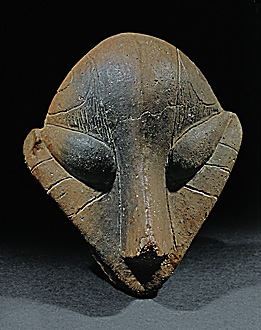 The
Vinča culture, also known as Turdaș culture or
Turdaș-Vinča culture, is the oldest
Neolithic culture in South-eastern Europe, dated to the period
5,500�4,500 BC.
(2) The
Vinča culture, also known as Turdaș culture or
Turdaș-Vinča culture, is the oldest
Neolithic culture in South-eastern Europe, dated to the period
5,500�4,500 BC.
(2)
In 1908, the
largest prehistoric Neolithic
settlement in Europe was discovered in the village of Vinca, just a
few miles from the Serbian capital Belgrade, on
the shores of the Danube. Vinca was excavated between 1918 and 1934 and was revealed as a
civilisation in its own right. Indeed, as early as
the 6th millennium BC, three millennia before Dynastic Egypt, the Vinca culture was already a
fully fledged civilisation. A typical town consisted of houses with complex
architectural layouts and several rooms, built of wood that was
covered in mud. The houses sat along streets, thus making Vinca the
first urban settlement in Europe, but being far older than the
cities of Mesopotamia and Egypt. And the town of Vinca itself was
just one of several metropolises, with others at Divostin, Potporanj,
Selevac, Plocnik and Predionica.
Archaeologists concluded that �in
the 5th and early 4th millennia BC, just before its demise in
east-central Europe, 'Old Europeans' had towns with a considerable
concentration of population, temples several stories high, a sacred
script, spacious houses of four or five rooms, professional
ceramicists, weavers, copper and gold metallurgists, and other
artisans producing a range of sophisticated goods. A flourishing
network of trade routes existed that circulated items such as
obsidian, shells, marble, copper, and salt over hundreds of
kilometres.�
|
The
Vinča Culture: ('Turdas-Vinca') |
The Vinca
culture flourished from 5,500
(2) to
3,500 BC (4) on the territories of
what is now Bosnia, Serbia, Romania and Macedonia. It got its
name from the present-day village of Vinca, 10 km east of
Belgrade on the Danube river, where over 150 Vinca settlements
have been determined.
There is no evidence of war or defences in the townships, and it
appears that the Vinca were a peaceful society combining
low-level agriculture with foraging and trade. They produced the
first known European examples of a 'proto'-script and were the
first people in the world known to smelt copper. They existed in
a similar state for almost 2,000 years, following which they
appear to have dispersed around the Mediterranean and Aegean.
Vinča settlements were considerably larger
than any other contemporary European culture, in some instances
surpassing the cities of the Aegean and early Near Eastern
Bronze Age a millennium later. The largest sites, some more
than 300,000 square metres may have been home to up to 2,500
people. (2)
We are told that they lived in spacious housing and separated
their dead in nearby necropolis. They had workshops, which
means skilled labour. They worked with several styles of pottery
and had their own particular artistic fingerprint which is seen
in both early Cretan and Sumerian cultures, which rose following
the demise of the 'Old Europe' heartland.
The First European Metallurgists:
Copper
working had been in progress in nearby Anatolia (Turkey),
for well over 1,000 years before it appeared in Europe
(5). One of the
most exciting finds for archaeologists therefore, was the discovery of
a sophisticated metal workshop with a furnace and tools
including a copper chisel and a two-headed hammer and axe.
"This might prove that the Copper Age started in Europe at
least 500 years earlier than we thought,". The Copper Age
marks the first stage of humans' use of metal, with copper
tools used alongside older stone implements. It is thought
to have started around the 4th millennium BC in south-east
Europe, and earlier in the Middle East.
The discovery
of a mine - Europe's oldest - at the nearby Mlava river
suggested at the time that Vinca could be Europe's first metal
culture, a theory now backed up by the Plocnik site. "These
latest findings show that the Vinca culture was from the very
beginning a metallurgical culture," said archaeologist Dusan
Sljivar of Serbia's National Museum. "They knew how to find
minerals, to transport them and melt them into tools."
The metal
workshop in Plocnik was a room of some 25 square meters, with
walls built out of wood coated with clay. The furnace, built on
the outside of the room, featured earthen pipe-like air vents
with hundreds of tiny holes in them and a prototype chimney to
ensure air goes into the furnace to feed the fire and smoke
comes out safely. He said the early metal workers very likely
experimented with colourful minerals that caught their eye --
blue azurite, bright green malachite and red cuprite, all
containing copper -- as evidenced by malachite traces found on
the inside of a pot.
The settlement was
destroyed at some point, probably in the first part of the fifth
millennium, by a huge fire. (1)
(Prehistoric
Metallurgy)
(Prehistoric
Mining)
The First European Writing:
Various
styles of zoomorphic and anthropomorphic figurines are hallmarks
of the culture, as are the Vinča symbols, which some conjecture
to be an early form of proto-writing
The Tărtăria
tablets (below) refers to a group of three tablets,
discovered in 1961 by archaeologist Nicolae Vlassa at a
Neolithic site in the village of Tărtăria (about 30 km (19 mi)
from Alba Iulia), in Romania. Two of the tablets are rectangular
and the third is round. They are all small, the round one being
only 6 cm (2� in) across, and two - one round and one
rectangular - have holes drilled through them. All three have
symbols inscribed only on one face
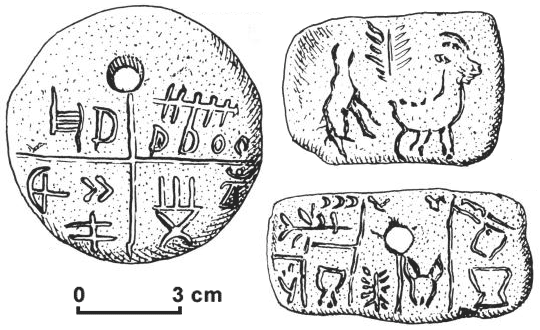 
The
tablets, dated to around 5,300 BC
(2),
bear incised symbols - the Vinča symbols - and have
been the subject of considerable controversy among
archaeologists, some of whom claim that the symbols
represent the earliest known form of writing in the
world. subsequent radiocarbon dating on the Tărtăria
finds pushed the date of the tablets (and therefore
of the whole Vinča culture) much further back, to as
long ago as 5,500 BC, the time of the early Eridu
phase of the Sumerian civilization in Mesopotamia.
This finding has reversed our concept of the origin
of writing, and it is now believed that the
Sumerians inherited a Vinca tradition of 'magical'
or 'meaningful' scripture, probably following the
collapse of the Vinca homeland c. 3,500 BC.
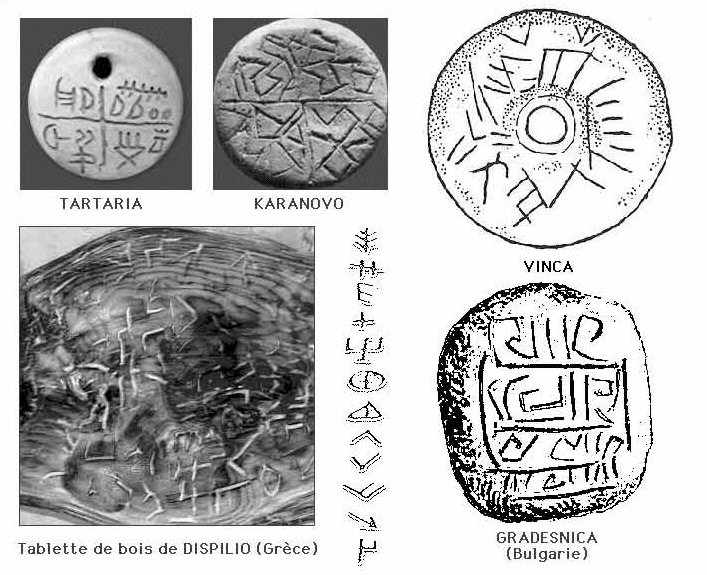
Similar motifs (above) have been found on pots
excavated at Gradeshnitsa in Bulgaria, Vinča in
Serbia and a number of other locations in the
southern Balkans.
(2)

Full list of
Vincan Symbols.
(More
about the Origins of Writing)
Article: (June 13, 2008): 'Europe�s Oldest Script
Found in Bulgaria', 18 May 2005.
'Ancient
tablets found in South Bulgaria are written in the oldest
European script found ever, German scientists say. The tablets,
unearthed near the Southern town of Kardzhali, are nearly 7,000
years old, and bear the ancient script of the Cretan (Minoan)
civilization, according to scientists from the University of
Heidelberg, who examined the foundings. This is the Cretan
writing, also known as Linear A script, which dates back to
XV-XIV century B.C. The discovery proves the theory of the
Bulgarian archaeologists that the script on the foundings is one
of the oldest known to humankind, the archaeologist Nikolay
Ovcharov announced Wednesday. Ovcharov, who is heading the
archaeological expedition in the ancient Perperikon complex near
Kardzhali, called the discovery �revolutionary�. It throws a
completely different light on Bulgaria�s history, he said in an
interview for the National Television'.
(3)
Vinca Art:
Recent excavations
at sites across Europe's biggest prehistoric civilization, the Vinca
culture, point to a great degree of sophistication and a taste for
art and fashion, archaeologists say. "According to the figurines we
found, young women were beautifully dressed, like today's girls in
short tops and mini skirts, and wore bracelets around their arms,"
said archaeologist Julka Kuzmanovic-Cvetkovic. The Vinca tribe who
lived between 5,400 and 4,700 BC in the 120-hectare site at what is
now Plocnik knew about trade, handcrafts, art and metallurgy.
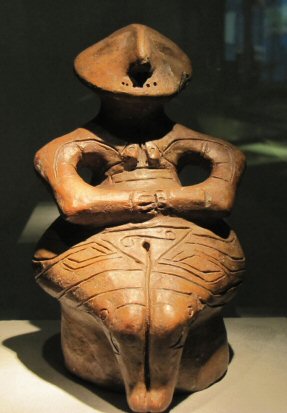
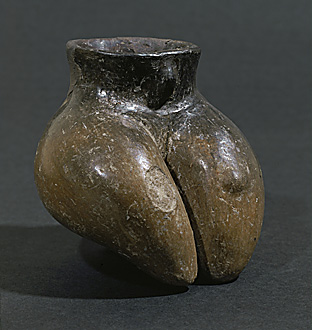
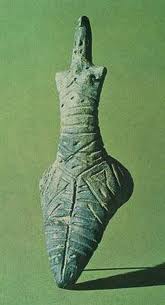
"They pursued
beauty and produced 60 different forms of wonderful pottery and
figurines, not only to represent deities, but also out of pure
enjoyment," said Kuzmanovic. The findings suggest an advanced
division of labour and organization. Houses had stoves, there were
special holes for trash, and the dead were buried in a tidy
necropolis. People slept on woollen mats and fur, made clothes of
wool, flax and leather and kept animals.
The
community was especially fond of children. Artefacts
include toys such as animals and rattles of clay,
and small, clumsily crafted pots apparently made by
children at playtime.
(1)
Similarities to Other Cultures.
What we have then is the record of a
civilisation that flourished in Europe between 6,000 and 3,500 BC
and which appears to have enjoyed a
long period of uninterrupted and peaceful living.
The 'Old European' Vinca pottery, artefacts and
writing all show an immediately noticeable similarity to what was
originally thought to be an earlier Ubaid Sumerian influence
from the middle east. In addition, the Cycladian/Cretan cultures are
suspected of having close close artistic and possibly religious
connections with the Vinca. Both of these cultures appeared
following the demise of the Old European Heartland, perhaps not so
coincidentally, at the same time as several other important
civilisations (Egyptian, Indus Valley, Western European, Maltese
Etc) appeared in the prehistoric record.
(Map of
distribution and styles of Vinca pottery)

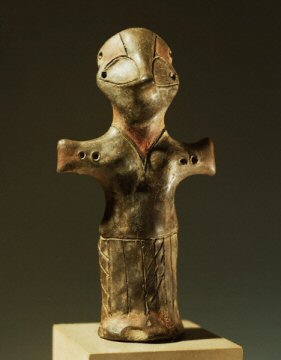
The Vinca pottery (above) is almost
indistinguishable from Ubaid Sumerian.
Several eminent
archaeologists of the time (such as Childe, Hood, Vlassa, Maccay),
were convinced that the Vinca had somehow been influenced or
'cradled into being' by the mistaken belief at the time that the
Sumerians were the 'Mother race'. However, much to everyone
surprise, more recent discoveries of earlier Vinca settlements have shown
quite clearly that events must have occurred the other way round as
the Old European settlements, along with writing, pottery, metallurgy and 'Ubaid'
style art, date to a thousand years before the first Sumerian
fingerprint, suggesting remarkably that it was actually a Western
European culture that influenced Sumerian development.
(More
about the Sumerians)

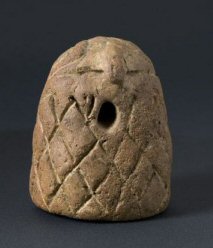
The Vinca
sculptures (above) show strong symbolic similarities to later
Cretan 'Mother-Goddess' figurines and what might be the earliest
representation of an 'Omphalos'.
Other similarities with cultures that followed the
Vinca's demise have been noted such as the
rise of the so-called
Cycladic and Cretan cultures, where the new
settlers arrived around 3,200 BC. with identical motifs
such as the snake, intertwined with the bird goddess
motif, the bee and the butterfly, with the
distinctive motif of the double axe, are found both
in 'Old Europe' and Crete. But the best evidence is
in the writing of Old Europe and the 'Linear A' script
of Crete, which are to all intents and purposes
identical.
(More
about Ancient Greece)
Gallery of
Images: Vinca Culture.
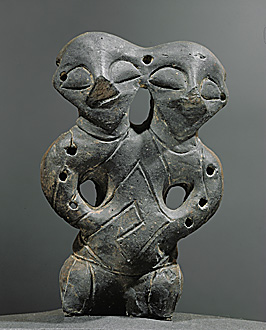 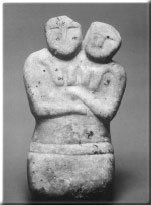
Left: Double-headed figure from
Gomolava-Hrtkovci, Serbia. Vinca-Plocnik Culture, Late
Mesolithic (5th mill. BC). (Photo Credits:
Carlos Mesa) Right: Double-Headed figure,
Cayonu, Turkey. Anatolian Culture
(6th Millennium BC).
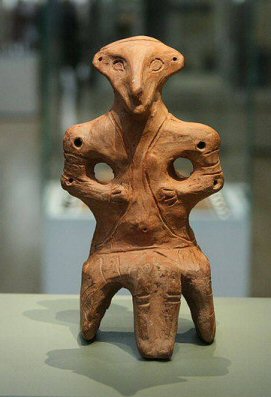
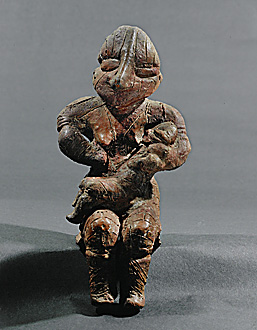
Seated Vinca
Figurines. (Right) Mother and Child.
(Prehistoric
Metallurgy) (Prehistoric
Mining)
(The Sumerians)
(Prehistoric Greece)
(Prehistoric Turkey)
(Bosnian
Pyramids) |
 The
Vinča culture, also known as Turdaș culture or
Turdaș-Vinča culture, is the oldest
Neolithic culture in South-eastern Europe, dated to the period
5,500�4,500 BC.
(2)
The
Vinča culture, also known as Turdaș culture or
Turdaș-Vinča culture, is the oldest
Neolithic culture in South-eastern Europe, dated to the period
5,500�4,500 BC.
(2)












